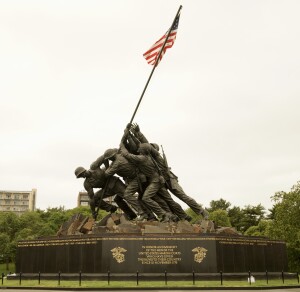On February 23, 1945, amid the brutal battle for Iwo Jima, a moment of triumph was captured in a single photograph that would become one of the most iconic images in American history. After days of relentless fighting against entrenched Japanese forces, a group of six U.S. Marines reached the summit of Mount Suribachi, the island’s highest point. There, they raised the American flag, a powerful symbol of resilience and sacrifice. The image, taken by Associated Press photographer Joe Rosenthal, embodied the courage of the Marines and the unyielding determination of American forces in one of the fiercest battles of World War II.
The battle for Iwo Jima had begun on February 19, 1945, as thousands of Marines stormed the black volcanic beaches under relentless enemy fire. The Japanese defenders, deeply entrenched in a complex network of tunnels and bunkers, made every inch of progress costly. Over 26,000 American casualties, including nearly 7,000 killed, underscored the brutal nature of the fight. The capture of Mount Suribachi was a crucial turning point, offering a strategic vantage point over the island, but the battle raged on for weeks afterward. Despite the hardships, the Marines pressed forward, determined to secure victory.
The flag-raising on Iwo Jima became more than just a battlefield event; it became a symbol of perseverance and unity. The photograph was widely circulated in newspapers and later served as the inspiration for the Marine Corps War Memorial in Arlington, Virginia. It reminded Americans of the sacrifices made by those who served and the price of freedom. Today, the memory of Iwo Jima lives on, not just in history books but in the hearts of those who honor the bravery of the men who fought there. Their legacy is a testament to the resilience of the human spirit in the face of unimaginable adversity.

